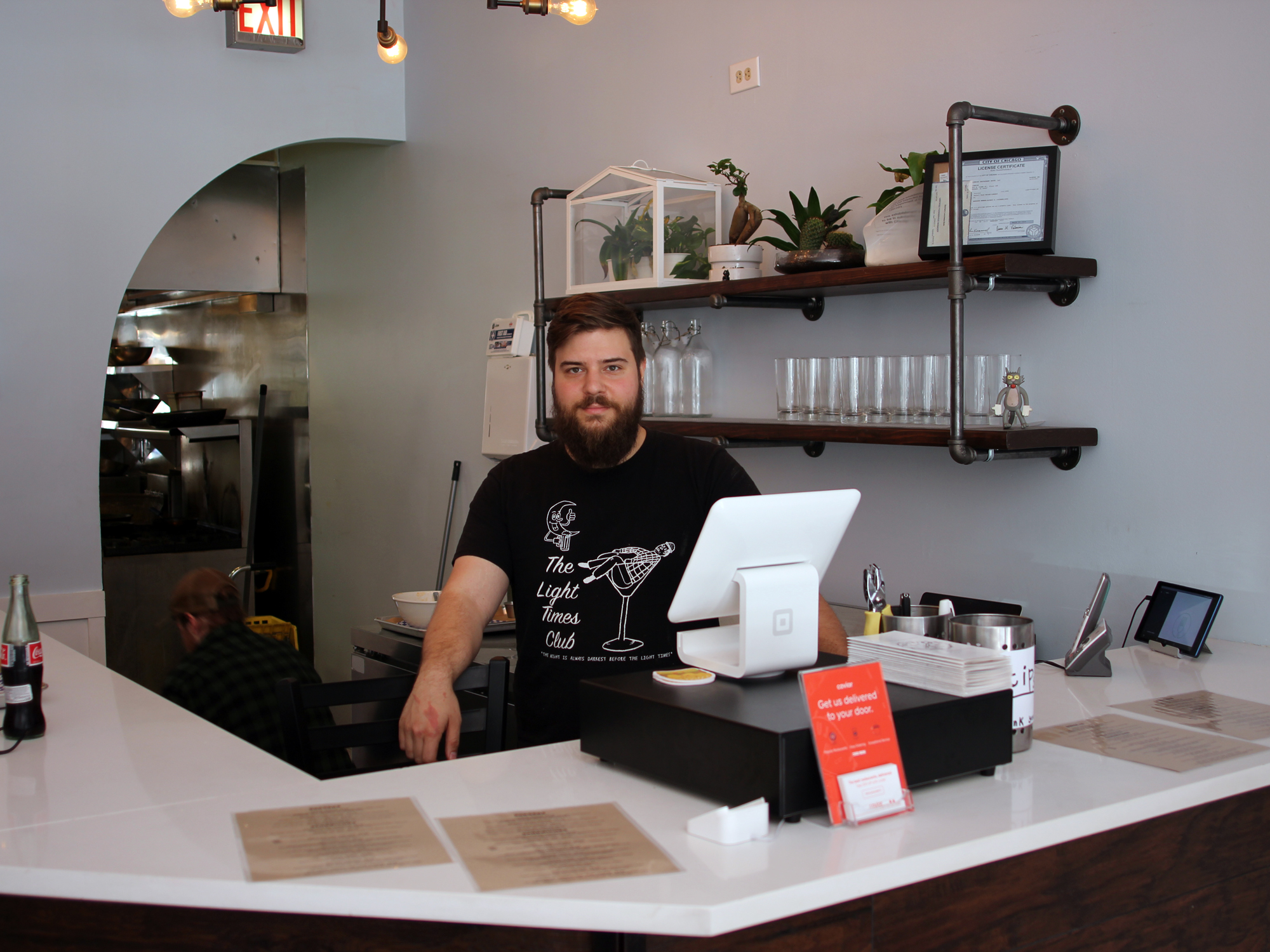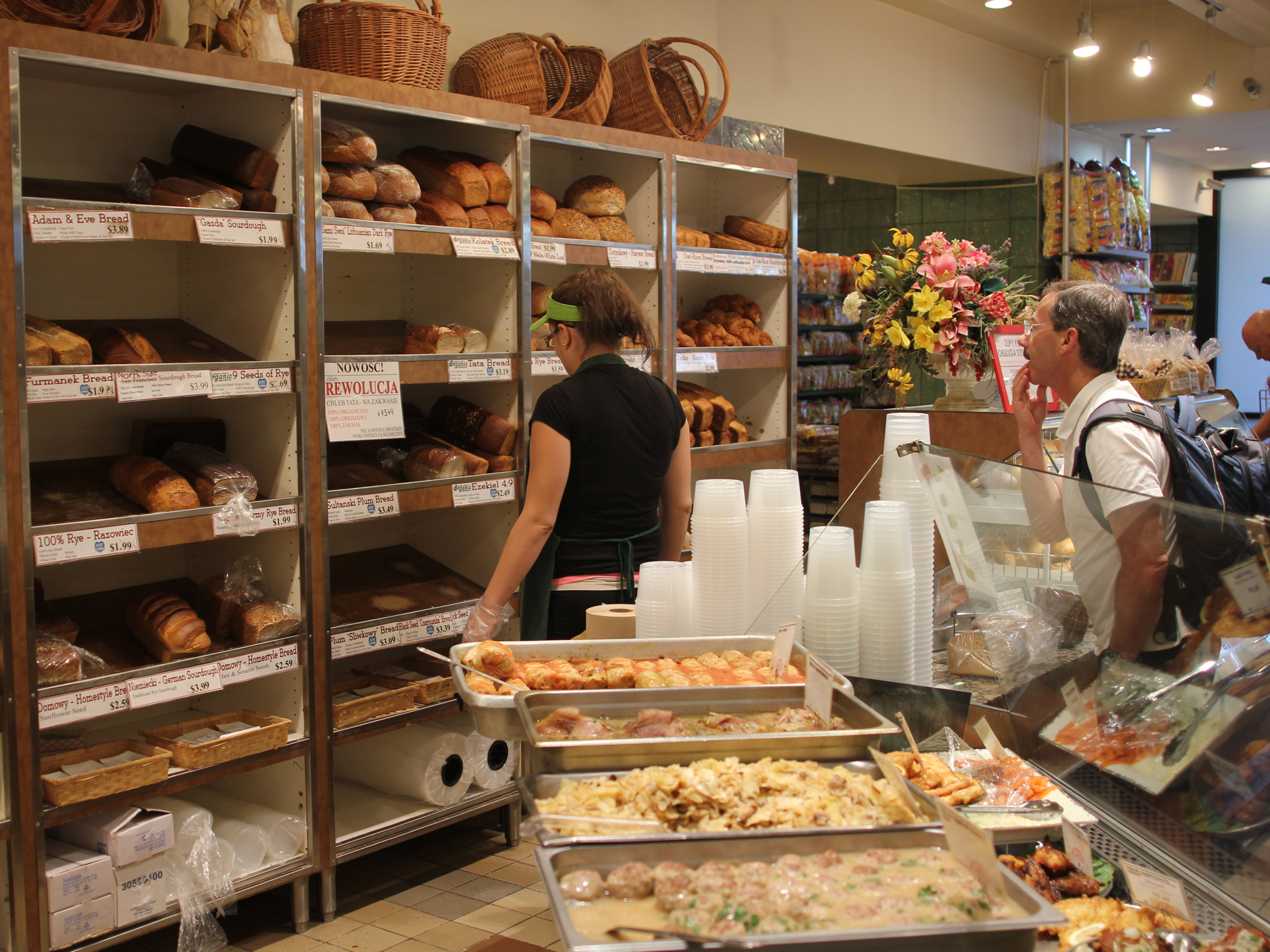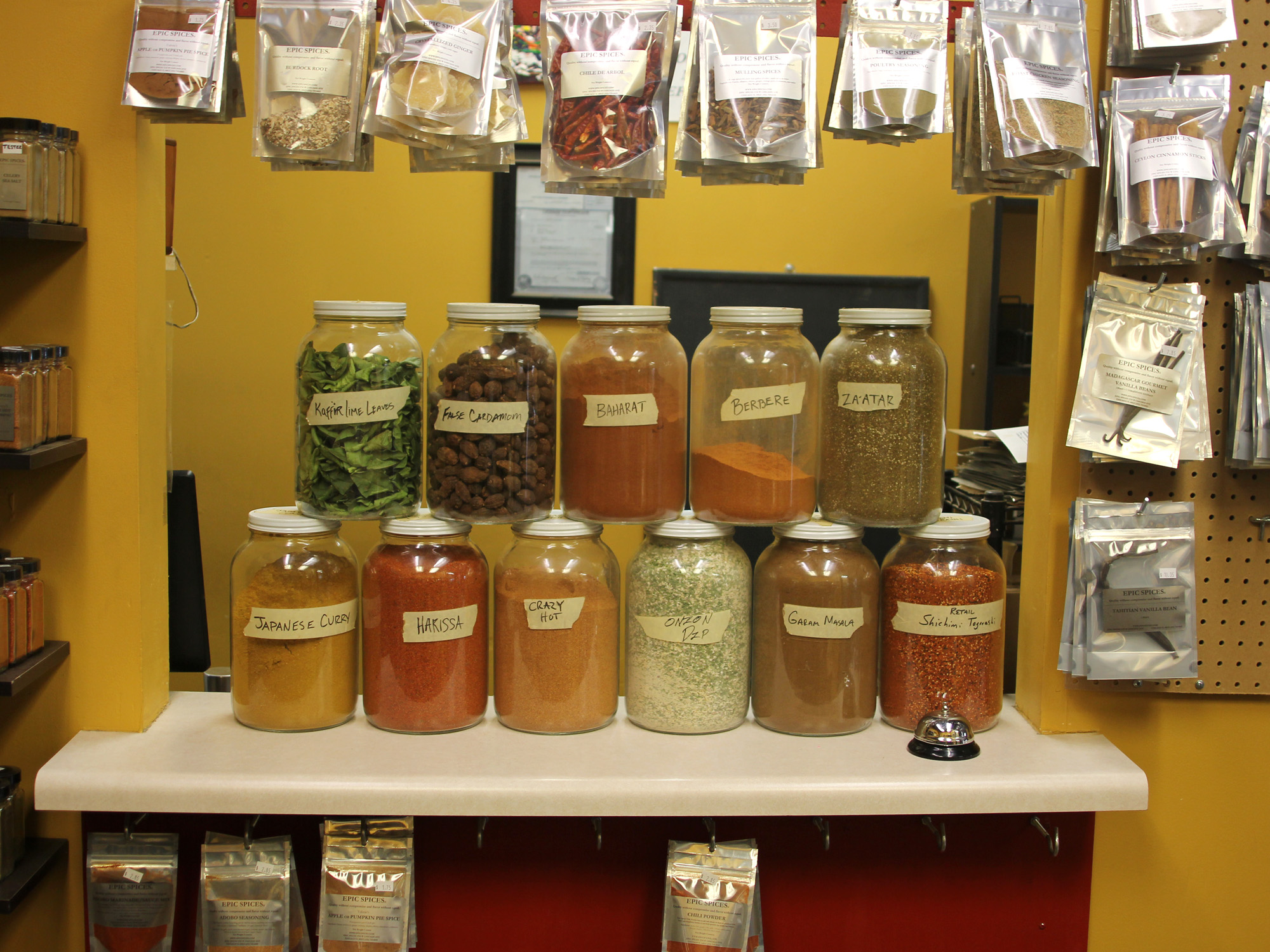The Desk
ONE OF THE BEST PLACES TO EAT IN CHICAGO, IT TURNS OUT, is at Rodrick Markus’ desk. The first time I visited his Rare Tea Cellar, tucked in an old warehouse building along Ravenswood, it was a couple of winters ago and I was there with chefs Scott Manley (then of Table, Donkey & Stick) and Phillip Foss (EL Ideas), along with a couple of Foss’s cooks.
And Markus was essentially serving us an impromptu tasting menu at 10:30 in the morning, pulling things like a magician from the clutter on his desk—such as a tray filled with truffles (five thousand dollars’ worth? More?), both white and black, the latter of which he sliced for us to try on some dense black bread with a gooey French cheese. “This is one of my favorite things, Delice de Bourgogne, with black winter truffles. And then Baker Miller brought me a loaf of their pumpernickel,” he said as he passed the plate around for us to nibble on.
Foss picked up a long-necked bottle decorated with colorful Japanese graphics of plums. “I’ve never heard of umeboshi vinegar before,” he said.
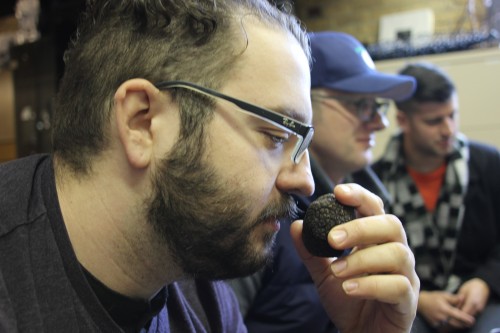
Scott Manley of Table, Donkey & Stick sniffs a winter truffle.
“It’s the bottom of the barrel, when they age umeboshis,” Markus said, handing Foss a plastic spoon. “I’m warning you, it’s so strong, I took a big spoonful of it and I tasted it for like a day.”
I dabbed my pinky on Foss’s spoon and tasted it—it was like salty plum cough syrup. “You know what the coolest thing about it is?” Markus asked. “It’ll cure any vegetable, in seconds. It’s almost like a mother vinegar. From every barrel that’s like 120 gallons, I think they get two liters at the bottom. I’m trying to get a barrel, and they’re like, are you crazy? They don’t understand the concept of barrels.”
The name being Rare Tea Cellar, next Markus rummaged for a tea press and poured us each a taste of a tea that had been steeping. “I want to share this with you guys, this is one of my all-time favorites,” he said. “It’s private reserve, Himalayan Moonlight tea. 100% biodynamic, it’s only picked in moonlight. About six thousand a kilo.”
He took a gentle sip and let it linger in his mouth for a second. “It’s super-fun. The fragrance is just—the first time I smelled it it was like the most beautiful woman walked in, and I was with eight of the scruffiest Indian guys you’ve ever been with in your lives. I was almost scared. Like, what is that smell, how is that possible?”
“Who’s got this on their menu in Chicago?” Foss asked.
“Grace has it, and, um, another place,” Markus said.
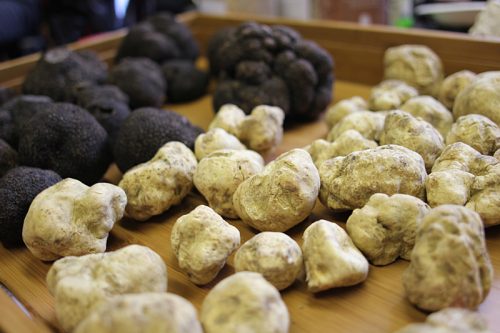
Truffles
His attention turned next to a entire leg of salt-cured ham, sitting in a wood and iron rack on his desk. The outside looked as hard and gnarled as if it had been carved out of wood, but strata of ruddy cured meat were visible under the dense skin. He flicked off some small pieces, flakes of ham, and passed them around. “This is not my usual jamon,” he said.
“What happened?” Foss said, suddenly worried that he just lost his access to something.
“No, no, I’ve got Spanish jamon all over the place,” Markus reassured him. “I’m still addicted to jamon. But this is a guy I’m working with from Woodland Pork. Basically he lets his pigs wild forage in the Appalachian mountains. He takes them like a team of dogs and lets them eat everything. When he first sent me a sample, I said, oh, it’s from Spain, and he said, ‘Thank you.'”
One of the cooks spied a bottle of Élixir Végétal, the original 138-proof form of Chartreuse, illegal to sell in the U.S. and prized among cocktail aficionados who bring it back from France (at that strength, you use it as a bittering agent rather than drink it). He asked Markus where he got it. “You gotta know people in Europe,” Markus said, with the air of a magician slipping out of answering a question about a trick. “I probably drink more of it than anyone in the U.S.”
He reached around on his desk and came up with a little bottle, with a computer-printed label showing that it was homemade. “Now this is over the top. This is Chartreuse elixir with white truffle,” he said, pouring a little dribble of it onto plastic spoons. “We’ve got this weird license from the city where you can bring in 5000 gallons of liquor to use for non-potable reasons, like making bitters,” he explained. “So we’re just infusing everything, I love it. I’m going to take some of this to the monks in France.”
“You’re going to take it to them?” Foss asked, making sure that he’d heard right—that a guy from Chicago was planning to school the monks who invented chartreuse on what flavors you can get out of their product.
“Sure,” Markus said, a little bemused at his own swagger. “Wake them up a little. Go big or go home, y’know?”
The Dealer
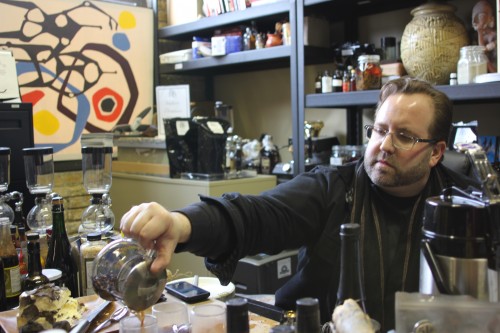
Rodrick Markus.
MEETING ROD MARKUS IS LIKE MEETING A CHARACTER FROM A MOVIE—someone like Casper Gutman, ready to tell you the whole story of how the Knights of Malta came to create a jewel-encrusted falcon, or one of those cultured Bond villains who knows his wines as well as his nuclear satellite intercept codes. (Thankfully, Markus only hunts the world for product that’s non-fissionable.) He’s big, well-dressed (almost always in black) and with gentle, courtly manners, even as he can be drily sarcastic, and he speaks the language of the chefs he deals with, so that high-end ingredients are “off the charts” or “sick” or “fucking insane.” As he tells you how he climbed through caves in China to find a particular tea, it seems impossible to imagine what experiences could have led him—led anyone—to such an Indiana Jones-esque life looking for things to eat and drink.
“My background was psychology and hypnotherapy,” he says. “I had a hard time making a living, and I always was enamored by what was rare and unusual.” One of those things, two decades ago, was tea. “I was tasting tea at all these shops all over Chicago, and even in San Francisco, and I found some niche arenas like oolongs and high mountain green teas, that I hadn’t experienced in my life before. Back then a lot of our research was in magazines, and you’d just read magazine after magazine, and look for a correlation with some interesting spot in China.”
Markus had never been to China at that point and spoke nothing resembling any form of Chinese, but “we found the one English-speaking person at one of the estates, and started a dialogue. That was back when there was no internet, no nothing. I just kind of did a blind deal, and started working with some farms out there, and learned as I was going. I can’t even remember how I got them the money, some kind of international money order, but eventually, a big bag of green tea shows up on my doorstep, and it was one of the best teas I’d ever had.”
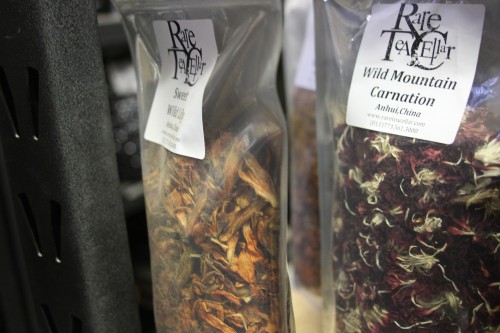
“We were looking for something that would be rare even in the country of origin. That’s always been a goal of mine,” he says. “If we’re bringing in a high mountain green tea, I don’t want to just bring in something that’s a great high mountain green tea. I want to bring in something that even if you were hanging out in the area, would be an exceptional varietal.”
Part of Markus’ persona is giving off an air of unquestioned assurance—when he says something is the best, you believe he’s tried enough to know. “Our position is, we don’t have competitors,” he told Foss with blithely tossed-off chutzpah while offering him some crazily expensive, hand-picked wild pistachios (“They keep like one nut out of every pound”). It’s the thing every dealer in rarities is really offering—his own stamp of approval, like the art dealer Lord Duveen telling the Rockefellers and the Hearsts that just because you could buy a Rembrandt, that didn’t make it good enough to be a Duveen Rembrandt.
But Markus freely admits that today’s presumption of expertise was earned the hard way—”I almost went broke ten times in the last fifteen years. I’d say for the first couple of years, we threw away more tea than we sold. But we were trying to build the market organically. And it’s through those experiences that we built the taste buds, and built the future of what we’ve become here.” Which is that, after years of hauling suitcases full of tea to restaurants and going on the road to make new contacts, now chefs come to him to find out what’s new and what’s good—as Foss and Manley had done.
“I almost went broke ten times in the last fifteen years. I’d say for the first couple of years, we threw away more tea than we sold.”
Markus’ push to take tea into fine dining restaurants started about 15 years ago because, he thought, “If they can sell wine for from thirty bucks to the sky, and no one has a problem buying it, there’s got to be a market for high-end tea.” One of the chefs he pitched was Paul Kahan, “and within about 30 minutes of meeting him, and tasting tea in the downstairs kitchen at Blackbird, we just hit it off and I took over his tea program.” Hotels with a large Asian clientele were another receptive audience; at the Park Hyatt in Washington, D.C., he stocked an entire tea room—”Every crazy, outrageous idea I ever had in the world of tea, they took it.” The tea room opened in 2006 with 64 teas on its menu.
Working with restaurants pushed him into offering the ingredients in the tea blends— “Chefs would call up and they’d want the blue cornflower petals from my Earl Grey. It was something I’d never even thought of—I’d always wanted to deal in some other products, but I was focusing on tea in the beginning.” That market appeared because, Marcus says, “I’d never looked at what it cost to blend it, but at what the final outcome was. I’ve never been scared to use real vanilla beans in blends. When you look at tea, even a $200-a-pound tea is about 50 cents to a dollar to make one pot. It’s so approachable, I just saw a real niche in that.”
The result of that is that Markus has an astounding proportion of the restaurant market for tea in Chicago. “I don’t think I realized how extreme it is,” another tea dealer told me. “He has all of the Michelin-starred restaurants. He has 80 to 90% of the high end restaurants.” Partly, this person indicates, that’s simply because Markus got there first, with a decade’s head start. But a picture is also painted for me of a tea business, that like coffee or craft beer, is in those early days where everybody knows everybody else and shares ideas—except Rod Markus, the man with no competitors.
For other tea dealers, Markus’ list of big name restaurant clients, and the fact that he also supplies trendy and unusual ingredients that chefs hear about and want to play with, make it almost impossible to crack the restaurant market, not just with other teas, but with other approaches to the subject of tea. “It’s an amazing chain reaction,” the dealer told me. “He’s in with one, he’s in with all.”
The First Time
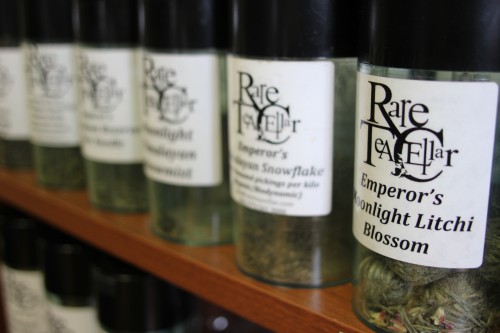
Pu-erh teas
ROD MARKUS HAS HIS OWN MEMORY OF HOW TEA cast its spell on him—he was a kid in London on a family vacation, and they went to have tea service. “When they brought out all the accoutrements to afternoon tea, I loved it. I loved that they were putting a strainer over my cup, and pouring the tea and the leaves, I loved the aroma.” In time he came to appreciate not only the ceremony of tea but the idea of breaking the afternoon to relax with this calming, convivial ritual— “I miss it when I come back to the States. Over there, it’s all these afternoon little delights, ‘Here, I want you to have a cracker and a cup of tea.’ It’s a treat to slow down a little. In the States it’s really hard to slow down with anything but alcohol.”
Conveying that experience, though, means not only supplying the tea but teaching restaurant staff how to serve tea properly. “We started early on training staffs all over the world, and I still train all our hotels and restaurants, and it’s a real learning process. It’s amazing how scared people are to boil hot water,” he says. “They’re like, if I’m out of town, how am I going to get hot water, and I’m like, have you heard of a place called 7-11?”
“It’s just so opposite of our culture,” he says. “Everyone has no problem making a pot of coffee and pushing the button, but to boil a little water and pour it in a pot, it’s like—whoa, really, I’m not putting a strainer in there? Oh my God.” Markus is especially against the kind of tea caddy that holds the tea in a ball—”How could tea possibly open up when it’s cooped up in a little ball?”
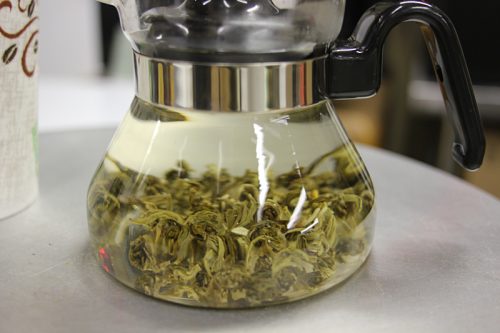
So it was hard for him a couple of years ago when his tea got national press—negative press, because it was mishandled, not just at any restaurant, but at account #1, Blackbird. In 2015 Eater’s Bill Addison ordered a $28 Rare Tea Cellar pu-erh, an aged and fermented type of tea from China that includes some of the rarest (and highest-priced) teas in Markus’ portfolio, and got what he called “tannic dirt… Not only did the staff not know how to handle such an expensive tea, but they assumed that a customer willing to spend that much on a beverage didn’t know how the tea should be prepared, either.”
Markus can only look pained when I bring Addison’s experience up. “That was a tough one to take,” he says. “I just think it was an off night. Right now, in the industry, there’s so much turnover in the front of the house, in servers. We go out of our way to train people in the intricacies, especially with pu-erhs and other things. But every once in a while, something gets a little loose.”
“And also it’s hard because some of the equipment that could be used tableside to make it even a better cup of tea, have so many little parts to each of the contraptions that people either want a simple mechanism to brew tea—or they just don’t want to brew tea,” he says. “It blows my mind that you go into a great restaurant, and everything is amazing, and you get to the final course, and it’s the most anticlimactic, slap something in a cup, here’s your tea.”
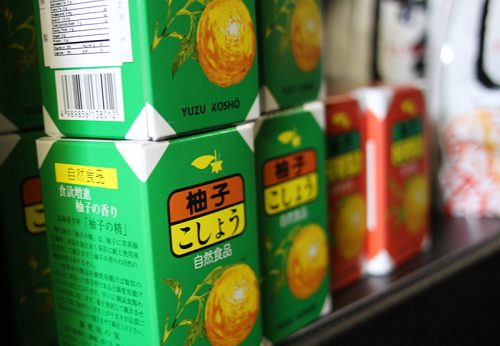
The F.U. Aisle
AFTER THE WIZARD’S WARREN THAT IS Markus’ office, you enter the warehouse. By comparison it’s clearly been organized by someone who prizes actually being able to find things to quickly fill an order, though the principles of organization still have their quirks—Markus refers to one row as the F.U. aisle (“This is all the things that make chefs go, ‘Where the fuck do you get that?'”). And even amidst the general tidiness, there are random, oversized bits of Asian bric-a-brac laying about, as if at some point Markus came into possession of a Chinese circus.
Today he offers some 5,000 items from 160 countries, he says. Half of his business is still tea—with half of that single-origin teas, and the rest tea blends he creates in-house. Truffles account for another quarter of his sales, and the rest is everything else he brings in or finds or creates. The new truffle, he says, is Matsutake mushrooms, a meaty Japanese mushroom (he gets them from the Pacific northwest) which has become a staple on high-end composed plates—partly because Markus made them possible for Chicago chefs to get and turn into a staple.
Exotic imports are still the star attraction, beginning with those black and white fungi, which he imports most of the year—black from France in winter, white from Italy and black from Australia in the summer. But what fills much of the warehouse now are the products he makes in-house, like every kind of dried fruit imaginable—bags of beautiful in-season fruit, freeze-dried to the crunch of a Cheetoh and an almost fluorescent version of their own color.
For chefs it’s a kind of instant molecular gastronomy, the most intense elemental expression of a flavor waiting to be added to a plate, as a crunchy texture or a lickable powder. I can’t help but think of the flavored wallpaper in Willy Wonka and the Chocolate Factory—the snozzberries really do taste like snozzberries, from the peak of the snozzberry season.
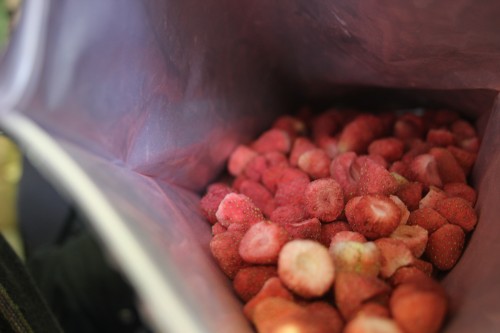
Freeze-dried snozz-, er, strawberries.
Collaborations with others using the rarities in his warehouse are increasingly part of his business—he makes a line of teas for Mariano’s, and he talks like a giddy fan about his collaborations with rock star Billy Corgan for Corgan’s tea house Madame Zuzu’s in Highland Park (which is, incidentally, where Markus grew up). “We’ll be having a meeting there, and—Billy is very recognizable when he takes his hat off,” he says of the bald, 6’3″ singer. “And I’ll see people come in and just stop and go—” Markus mouths the words OHMIGOD IT’S BILLY CORGAN.
Another impactful collaboration has been the one with Chicago mixologist Adam Seger, Rare Botanical Bitters. Seger was one of the first figures in Chicago cocktail’s revival, and one of the first to get a product on shelves with his Hum botanical spirit, a floral, slightly bitter spirit like amaro or vermouth for use in mixed drinks. Seger and Markus have been playing with something like 200 different ingredients mixed into alcohol to make tinctures, and the office shelves are dotted with yellow jars of things floating in alcohol, like the creepy specimens in a high school biology lab.
Markus refers to one row as the F.U. aisle—“This is where you get all the things that make chefs go, ‘Where the f— do you get that?’”
Their first collaboration to reach the market was called Balsam, and it was essentially “Instant Vermouth”—solving the problem that vermouth is nearly always stale in America, by removing the part that oxidizes, the wine. Instead, you added Balsam, a tincture made from various botanicals (including some of Markus’ rare teas) to a fresh glass of wine, and you had a complex-tasting drink of your own design. The hitch was, because it didn’t actually contain the wine, it couldn’t legally be called vermouth in the U.S.—it had to be labeled, accurately but prosaically, as “vodka with fruit and spices.”
Now he and Seger are expanding on that beginning with a line of four actual vermouths with different flavor profiles under the Balsam name, which they just debuted in New York and will release in Chicago in the next few days. This too comes at the end of a long regulatory struggle—Markus and Seger were determined to include wormwood in the recipe, legally required in Europe for vermouth to be called vermouth, but a scary product for U.S. regulators. “They’re all, what if people get sick—it’s such a minute amount. But if you’re going to do something, do it for real.” He thanks his luck for partnering with the calm, laid-back Seger—”I swear, if I didn’t have Adam as my partner, I would have gone crazy.”
To Markus, the idea is that all these ingredients exist to be played with and mixed and experimented with, not just by him, or even by chefs and bartenders, but by anybody who buys a bottle and has the urge to tinker. It’s the American spirit of innovation that produced cocktail culture in the first place. And he just shakes his head at the idea of a new era of cocktail creativity being ground to a halt for someone to make sure it follows rules, he says, that were invented in 1905.
“The system is so dated in the U.S.,” he says. “They’re trying to make all this money for the schools and this and that, it’s like, let people come out with every widget of alcohol they want. Just control the flow. Give ’em the license and let them get it out, as long as it’s not going to hurt anybody.”
Gallery: 10 Treasures from Rod Markus’ Cellar
I asked Rod Markus to pick out some items from his catalog that are affordable and would enhance cocktails and dishes for the home mixologist and cook. His warehouse is not normally open to the public, but you can order from his website.
The Hundred Dollar Doughnut
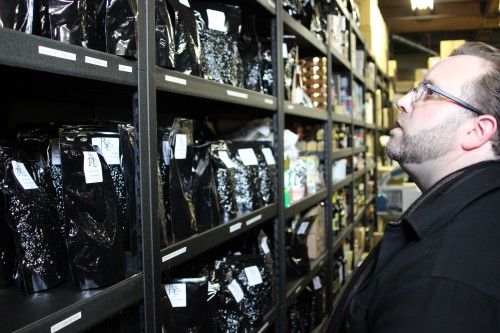
IT WOULD BE EASY TO MAKE A POPULIST CASE against this business of searching the world for new taste sensations, to portray it as decadent. As Jack Nicholson’s gumshoe asks the depredatious zillionaire in Chinatown, “Why are you doing it? How much better can you eat?”
At the highest level, fine dining is about the promise that something could be better than any example of that thing that you’ve ever had before—or completely unlike anything you’ve had before. Usually, that taste is in such tiny quantities that the taste is just a fleeting sensation and then a memory, of truffle on cheese, of Himalayan tea, of Appalachian iberico ham. Good magicians know not to leave the trick onstage too long.
Certainly when you get to the most exotic and highest-priced items, as with wine or anything else, there’s no rational market making decisions—it’s all about the projection of an image, for the buyer and the seller. That was undoubtedly the case when Markus’ pu-erhs started turning up on the menus of restaurants at as much as $200 a pot. I asked him if anybody ever bought those, or if they were just there for show, and he admits they’re not exactly flying off the menu—”A few times a year,” he says. They’re there, really, to expand your conception of what tea could be worth—of how good it could be.
$200 cups of tea are the kind of thing that makes normal people shake their heads. But I think it’s a mistake to see the desire for such things just as an elitist taste. It’s a way of exploring the planet, of knowing that this old world still has surprises up its sleeve and will never run out of new flavors and experiences. That seems a pretty deep-seated human desire, for at least some of us.
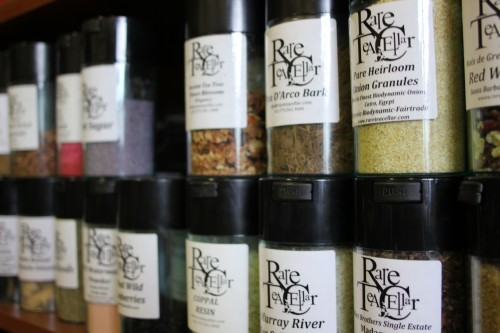
And the other thing is that however froufrou it may ultimately be, any foodstuff, by definition, begins with some kind of farmer (or at least gatherer). Farmers with oddball products that couldn’t break into the industrial food megasystem find their opportunity with someone like Markus, who can find them an audience where obscurity is a selling point.
Interestingly, after so many years of scouring the far corners of the world for exotic tastes, Markus is finding and buying more and more of them from an undiscovered country called the midwest. He’s distributed Blis, the high end producers of maple syrup, vinegars and other things from Michigan, from their beginning, and he gets volubly excited when he talks about one of their more recent projects—”Putting red boat fish sauce in a bourbon barrel. It’s stupid brilliant! I mean, who wants straight fish sauce? Let’s make it a little more interesting!”
“We have this team of farmers in central Illinois,” he says, “and they said, we want to start working with you. And I’m thinking they’re farmers, what are they going to have in central Illinois that’s so exciting, that I can move. And they’re like, we grow aronia berries. And I’m like, that’s unbelievable! It’s this berry, that’s like a chokeberry, kind of a cross between a currant and a blueberry, and it’s a really super-high antioxidant berry. Just deep. To get some of that local terroir, I love it.”
For any crop like that to have a chance at a bigger market, it has to start with the people who are willing to pay too much and try it sight unseen, for its novelty and the thrill of discovery. It may not work out—since I tried it a couple of years ago, Woodland Pork in Kentucky has given up trying to make Jamon Appalachia—but that’s the only way to find out.
At one point while we were poking around his warehouse, Markus summed up his attitude toward the quest for new tastes and experiences. “If someone offered me the best doughnut in the world, and it was a hundred bucks, I’d try it,” he says. “I might not have it twice, but I’d try it. You never know!”
Michael Gebert is the hundred dollar doughnut of editors of Fooditor.
Latest
Join the Discussion
After you comment, click Post. If you're not already logged in you will be asked to log in or register with Disqus.















